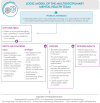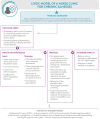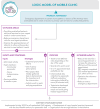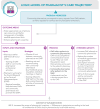Organizational innovations related to Primary Care Access Points (GAP) for unattached patients in Quebec: a multi-case qualitative study
- PMID: 39395972
- PMCID: PMC11475358
- DOI: 10.1186/s12875-024-02614-y
Organizational innovations related to Primary Care Access Points (GAP) for unattached patients in Quebec: a multi-case qualitative study
Abstract
Background: Being attached to a primary care (PC) provider is at the core of a strong primary health care system. Centralized waiting lists (CWL) for unattached patients have been implemented in eight provinces of Canada to support the attachment process. In Quebec, the Ministry of Health mandated the implementation of Primary Care Access Points (GAP) across the province to help unattached patients navigate the health system while awaiting attachment through the CWL. Several local health territories developed complementary innovations to the GAP to respond to local population needs. This paper aims to describe five organizational innovations implemented locally.
Methods: This multi-case qualitative study was conducted in four local health territories in the province of Quebec. Fifty-two semi-structured interviews with healthcare managers, nurses, physicians, other health professionals and administrative staff were conducted between April 2023 and April 2024. An interview guide was developed based on existing frameworks on the implementation of innovations and the evaluation of the GAP. Thematic analysis was conducted using NVivo software. Inductive and deductive approaches were used to develop relevant codes and themes. Logic models were built to describe the organizational innovations.
Results: Five organizational innovations are described. First, a multidisciplinary clinic aimed at responding to patients with mental health issues was implemented. Second, a nurse clinic was implemented to provide temporary care for patients with unstable chronic illnesses. The third innovation is a mobile proximity clinic where unattached GAP patients are first evaluated by a paramedic before receiving care from a nurse. Fourth, a pharmacist trajectory was implemented to increase engagement of community pharmacists to respond to GAP patients. The last innovation is a decentralized GAP offering in-person nursing care to unattached GAP patients.
Conclusions: Descriptions of these five innovations are key to inform other territories and provinces on ways to improve access for unattached patients while they are waiting to be attached. The introduction of the GAP and the organizational innovations, suggests a transition where access to PC services does not rely solely on attachment status.
Keywords: Access; Organizational innovations; Primary Care Access Points; Primary care; Unattached patients.
© 2024. The Author(s).
Conflict of interest statement
The authors declare no competing interests.
Figures






Similar articles
-
COVID-19 - an opportunity to improve access to primary care through organizational innovations? A qualitative multiple case study in Quebec and Nova Scotia (Canada).BMC Health Serv Res. 2022 Jun 8;22(1):759. doi: 10.1186/s12913-022-08140-w. BMC Health Serv Res. 2022. PMID: 35676668 Free PMC article.
-
A comparative analysis of centralized waiting lists for patients without a primary care provider implemented in six Canadian provinces: study protocol.BMC Health Serv Res. 2017 Jan 21;17(1):60. doi: 10.1186/s12913-017-2007-8. BMC Health Serv Res. 2017. PMID: 28109279 Free PMC article.
-
Explaining variation of implementation outcomes of centralized waiting lists for unattached patients.J Health Organ Manag. 2019 Aug 8;33(5):563-587. doi: 10.1108/JHOM-10-2018-0303. Epub 2019 Jun 28. J Health Organ Manag. 2019. PMID: 31483206 Free PMC article.
-
Typology of organizational innovation components: building blocks to improve access to primary healthcare for vulnerable populations.Int J Equity Health. 2020 Oct 6;19(1):174. doi: 10.1186/s12939-020-01263-8. Int J Equity Health. 2020. PMID: 33023575 Free PMC article. Review.
-
Healthcare stakeholders' perceptions and experiences of factors affecting the implementation of critical care telemedicine (CCT): qualitative evidence synthesis.Cochrane Database Syst Rev. 2021 Feb 18;2(2):CD012876. doi: 10.1002/14651858.CD012876.pub2. Cochrane Database Syst Rev. 2021. PMID: 33599282 Free PMC article.
Cited by
-
Determinants associated with receiving a medical appointment through the primary care access points for unattached adults in Quebec: A cross-sectional study.Healthc Manage Forum. 2025 May;38(3):178-185. doi: 10.1177/08404704241301773. Epub 2024 Nov 24. Healthc Manage Forum. 2025. PMID: 39581885 Free PMC article.
References
-
- Shi L, Macinko J, Starfield B, Wulu J, Regan J, Politzer R. The relationship between primary care, income inequality, and mortality in US states, 1980–1995. J Am Board Fam Med. 2003;16:412–22. - PubMed
MeSH terms
Grants and funding
LinkOut - more resources
Full Text Sources
Miscellaneous
